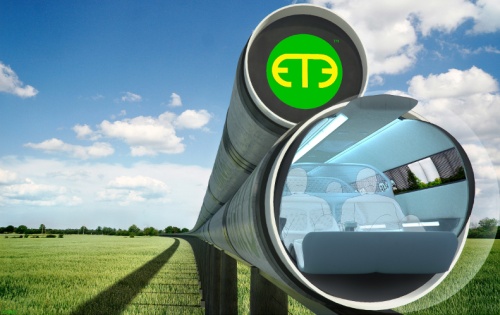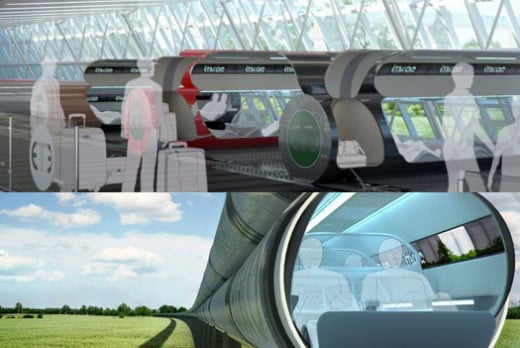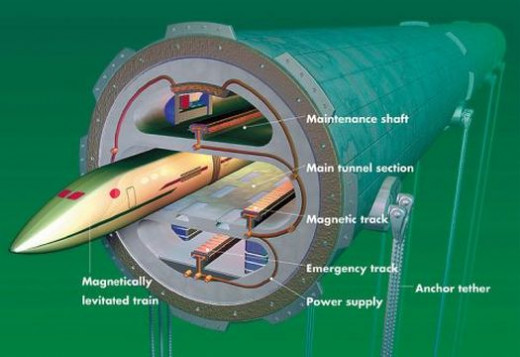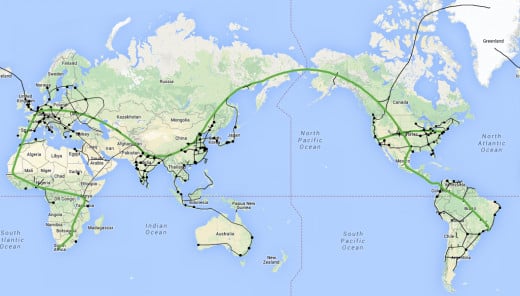Future of traveling: with 4,000 mph around the world in 6 hours

Traveling around the world in merely 6 hours is impossible? Perhaps for now, but this seems to be going to change since the American organization ET3.com Inc. is currently developing a spectacular transportation system that may turn this future fantasy into reality. An article on what traveling in the future may look like.
About ET3
First, let’s get acquainted with ET3. ET3 stands for ‘Evacuated Tube Transport Technologies’. This is an organization that is in possession of the patent on Evacuated Tube Transport (ETT) and owned by many license-holders. Everyone who supports ET3’s mission is welcome to become a member, provided that certain eligibility criteria are met. De organization is the result of the ideas of Daryl Oster, who laid the groundwork for his ideas in the 80’s, refined them during the 90’s and received his first patent in 1999.
This patent had not escaped the attention of Chinese scientist Dr. Zhang Yaoping, who showed great interest in ETT, which he claims has the potential of becoming the best transportation system ever developed for the whole world by mankind. Dr. Zhang had contacted Oster, which eventually enabled him to bring an ET3-license over to China in 2001. The next year, during Fall, Oster and his wife traveled to China to personally assist Dr. Zhang at the official initiation of ETT research at the University of Chengdu, an educational institution renowned for its transportation engineering. The trip lasted four months and during this time, the scientists came to an agreement about exchanging technologies related to the ET3 Project and the HTS Maglev Project (a transportation related research that was already in progress at the time at the University of Chengdu). Furthermore, Oster’s visit formed the start of several ETT programs. Later, several other educational institutions started researching ETT as well, among them the Chinese Academy of Sciences, the NJT University of Beijing and even the Chinese Ministry of Railways. Ever since, many other experts have initiated researches to the promising technology themselves.

Technology
Now, it’s time to have a look at the technology itself, that is focused on transporting people and goods in magnetically hovering capsules that move without resistance through a network of vacuum tubes. These capsules are roughly the size of a car, weigh a modest 400 pounds and will have the ability to transport either six people or 800 pounds of cargo. Given their relatively small size, the amount of materials needed to build them is moderate.
Electric motors are used for getting the capsules into the tube network while airlocks prevent any air from coming in. Once the capsules have entered the network, the vacuum tubes do the rest. There is no requirement for extra energy, since the energy released when slowing down can be re-used. Due to its highly efficient energy consumption, ET3 is capable of providing 50 times(!) the amount of transport an electrified train or steam-powered car can. Also, there is hardly any manual labor needed for operating the capsule other than entering its destination.
The speed of this particular kind of transportation is bedazzling. For local traveling, the speed is set to be ‘only’ 370 miles per hour. For international trips however, ET3-engineers and researchers aim for an astonishing 4000 miles per hour. Just to give you a clue of exactly how fast that is: seven times the cruise speed of an aircraft with powerful engines and five times the speed of sound! Such a speed will enable a trip from New York City to Beijing for instance to take two hours only.

Safety
In the rare event that the capsule will suddenly come to a standstill, it will manually be transported to the nearest emergency exit which will be placed in the tube network after every mile. The brake system is automatic hence not operated by human hands. In case the brakes fail to function properly, several back-up systems will be available to solve this problem. Compared to a car, a train or an aircraft, failure of ET3’s brake system is unlikely. Furthermore, the transportation system will be subject to continuous, automatic inspections. As a result of that, parts will be replaced in a timely manner if necessary.
Health
ET3 traveling will be very safe and bring no health risks along. The extremely high speeds will cause passengers to be subjected to G-forces, but only to a degree. To give you an idea: when you are in a roller coaster, you may be subjected to up to 3G, whereas this is 1G when you would be traveling in an ET3 capsule. Given the fact that us humans can handle up to 8G during a brief period of time, the high speeds will not cause any issues.
Also, capsules will be provided with oxygen (including a spare supply) to enable passengers to breath normally. It’s comparable to the oxygen system used in submarines. Terminals will be equipped with medical facilities. In the event a passenger gets sick while traveling, an emergency button will be pushed, causing the capsule to be brought to the nearest emergency terminal. Heart sensors will help to intercept any medical emergencies as well. And good news for people who suffer from claustrophobia: the space available to every passenger is larger than in an airplane for instance.

Expensive? Certainly not!
As pointed out earlier on in this article, building the capsules will be relatively cheap due to the limited amounts of materials required. The costs for building the tube network won’t be too bad either: an estimated 2 million dollars per mile for an ET3 system for local trips. Keep in mind too that there is little energy necessary in order to operate this transportation system – thus keeping energy costs down significantly – since it’s developed in such a way that it simply makes use of the laws of physics. Some license-holders even believe that energy costs can be kept low enough to enable the profits of advertising to cover the expenses.
Future
In 2011, ET3 won its first award, Commercial Product of the Year, at the 7th annual DaVinci Institute Inventor Showcase in Denver, Colorado. Winning this award gives hope for the future, since there will be lots of public support required to make the ET3 Project happen. Provided everything goes well, the planning is as follows:
2 years: a 3 mile demonstration will be held at 375 mph;
5 years: a 300 mile tube network connecting major cities will be established;
10 years: national networks will be erected in most major countries;
20 years: a global tube network will be established, replacing up to 90% of current global public transportation.
My vision on ET3
The story sounds great – almost too great. However, reading it like this, it doesn’t sound overly complicated at all. And hasn’t mankind proven himself already on numerous occasions when it comes to technologic and scientific developments? Think of something ‘simple’ like a photo camera. You push a button and all of a sudden you captured the view of something or someone. You don’t really think anything of it usually, but let’s be honest here – isn’t that just incredible?
In my opinion, we shouldn’t approach ET3 with fear, but give it a fair chance instead. After all, there is no denying that we have entrusted our safety to far less safe transportation means such as cars, trains and airplanes. Should ET3 obtain the chance it deserves, then humanity can make itself up for the next scientific milestone: for the first time in history, public transportation will be silent, environment-friendly, incredibly fast and cheap!
Sources







